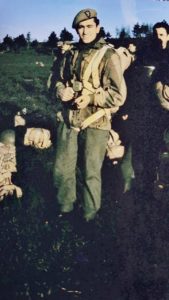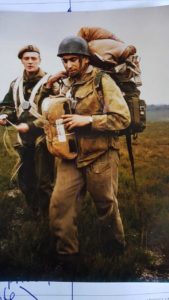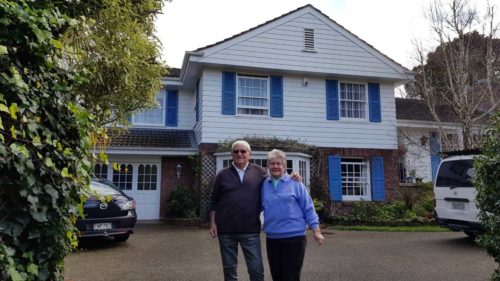He was a kid in WWII, became a member of the SAS in 1959 and ended up spending the last half century in Howick. The Times takes a trip down memory lane with John Jones, now a prolific writer and very much a part of the community

As a youngster, John Jones was used to picking his way through the bombed-out rubble of his London neighbourhood.
“This devastated area become our playground,” he said.
When the German night-time bombings – the Blitz – started in London in 1940 early on in World War II, Jones was 7.
In 1943 he recalls holding the lifeless body of his friend George May, 12, in a Battersea street.
Young George had found a live grenade. Jones reckons the unexploded ordinance was accidentally dropped during army training exercises.
It was four months before Jones’ 10th birthday but so many years on, the image remains etched in his sub-conscious.
A long-time Howick resident now, he turns 85 next month and shows no signs of easing up at all. A self-declared active relaxer, John’s enthusiasm spills over to all things.
Even now he is thinking of a trip overseas, and a project in the home’s mature gardens.
The former British special forces soldier, builder and surveyor and all-round sportsman looked for something to keep him occupied in retirement.
“In February 1996 I was encouraged by my wife (Maureen) to attend a six week beginners’ writing course at the Uxbridge Centre.
“This was immediately followed by a small social group of like-mined wannabes. From there, by following the guidelines laid down by our tutor, over the next 19 years my stories seem to take on a life of their own.”
As well as this latest work of fiction, Jones has churned out other work including a sizeable autobiography and a smaller personal history – tens of thousands of words.
“I can honestly say the Uxbridge writers course has been a great influence in my development.”
Too young to enlist during WWII, and excluding his wartime experiences as a young boy during the Blitz on London, he has not served in any campaign but still became a soldier.

He undertook compulsory National Service in the British armed forces during the early 1950s which required a commitment of two years in the regular army which he completed in November 1953. This was followed by three years and six months compulsory service in the Territorial Army.
“In 1959 (at 26) I volunteered for service with the 21st Special Air Service (Artist Rifles) TA where, following my successful completion of their selection course, I eventually attained the rank of Sergeant,” he said.
“During this same period I was gainfully employed as a Clerk of Works and Property Surveyor before emigrating with my wife and two-year-old son to New Zealand in August 1967.
“When I arrived in New Zealand 51 years ago, Howick was just a small village with a fire station at one end and a small petrol garage at the other.
“Otherwise, with the exception of the Prospect Hotel, not another restaurant in sight.”
Howick appealed in many ways to the family as it reminded him of similar small townships in rural England.
“So against the advice of office colleagues who said it was too far from Auckland, I purchased a large section in Selwyn Road.”
A complete set of house plans was designed and drawn by Jones on their kitchen table in Panmure.
Jones had the skills and determination. He had worked as a draughtsman for NZ Forest Products and Fletcher Construction, and eventually Pinex Fixing Service as contracts/area manager for its central Auckland division until his retirement some 20 years later.

Selwyn Road’s development was hard, back-breaking work and done in his spare time.
“Nine months later we eventually moved into our beautiful new house that still required all interior joinery, fixtures and fittings, plus external and internal painting to complete,” he said.
“We still had the driveway and landscaping to tackle but that came much later.”
To meet the locals, he was encouraged to join Howick Round Table where he became an active member.
“During those early years I also had the pleasure of coaching youngsters at Howick Fencible Soccer Club, the privilege of a long involvement with the Masonic Lodge and continuing membership of Howick Returned Services that includes both UK and NZSAS Associations,” said Jones.
His current sporting activities include full membership of Howick Bowling Club and, until recently, karate and golf.
He is one of the founding members of Whitford Park Golf Course (about 1972). In the armed forces he was heavily into boxing and football with the Royal Engineers. There is also time these days for Howick Probus.
But all these years later, sometimes his mind will drift to more cruel times, times and descriptions which family and friends insisted ought to go in unadulterated.
“They said to put it all in because that’s what happened. You’ve written as you saw it as a youngster…
Because the family lived near main line – Waterloo/Clapham Junction – they were obvious targets for German bombers. The bombs sought out not just the rail lines, but the munition factor and train turn tables.
They lost their first house there. It was reduced to a shell and only the scullery remained.
They often slept in their 9×6 bomb shelter before moving to another home.
“Another vivid and terrifying memory is witnessing the German V1 flying bomb- called Doodlebugs – up fairly close,” he said.
He and a mate were heading back from the cinema in 1944 and bore witness to unforgettable stuttering of a Doodlebug. They took cover in Battersby Dogs Home where they felt this monstrosity rocket past.
“The things that I remember are still very fresh – if I was to talk about something it was if I was right there.
“It’s still very disturbing…it’s as if I was there, it’s like looking at a picture … I’m reliving it.”
- John’s book “Two over Easy” is available at Poppies book shop on Picton Street or email jfmjones@xtra.co.nz.









